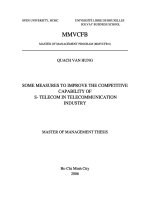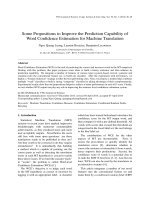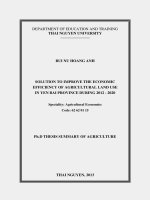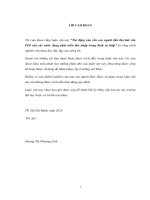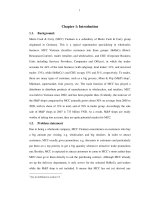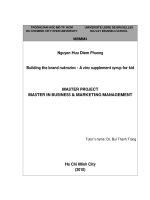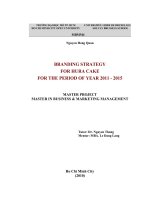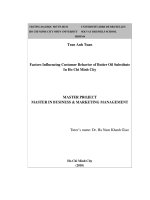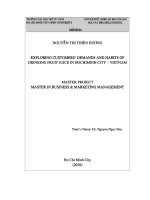Marketing strategy to improve the customers loyalty of trung thủy group corporation master project in business and marketing management
Bạn đang xem bản rút gọn của tài liệu. Xem và tải ngay bản đầy đủ của tài liệu tại đây (1.49 MB, 51 trang )
TRệễỉNG ẹAẽI HOẽC Mễ TP. HCM
HO CHI MINH CITY OPEN UNIVERSITY
UNIVERSITE LIBRE DE BRUXELLES
SOLVAY BRUSSELS SCHOOL
MBMM4
TRAN MAI DOAN THAO
MARKETING STRATEGY
TO IMPROVE THE CUSTOMERS LOYALTY OF
TRUNG THUY GROUP CORPORATION
MASTER PROJECT
MASTER IN BUSINESS & MARKETING
MANAGEMENT
Tutors Name: Dr. Ha Tran Minh Quan
Ho Chi Minh City
(2010)
DECLARATION
I ensure that this thesis: "Marketing strategy to improve the customers’ loyalty
of Trung Thuy group corporation" is the work of my own research.
The data and information used in this thesis is true.
Author
Tran Mai Doan Thao
Page | ii
ACKNOWLEDGMENTS
First, I must thank God for giving me the strength to complete this thesis. With Him all
things are possible. My thanks to the people who have helped me throughout this
Master program. Without their support, encouragement, and understanding, I would
never have achieved my final academic destination.
I wish to express my deepest respect and heartfelt thankfulness to my tutor – Dr. Ha
Tran Minh Quan - for their patience and encouragement. His consistent support and
guidance throughout my time were critical to the successful development and
completion of this thesis.
I also would like to express my deepest respect and heartfelt thankfulness to Solvay
Brussels School and Ho Chi Minh City Open University, Profesor Jean-Pierre BAEYENS
and the administrative staffs at ULB – Mr. Serge Bywalski and OU – Ms. Nguyen Thi
Mong Thuy for their generous help and encouragement during my master studies.
Special Thanks go to my parents who always encourage and support me. I am grateful
to them for their love, understanding, prayers and encouragements.
Finally, I would like to thank all my friends and colleagues for their support, assistance,
kind friendship and insight particularly. Without their help, the pursuit of master degree
would have been more difficult and lonely.
Page | iii
Customer’s loyalty has always been a burning
issue in any business, so in my assessment, this
is a realistic and highly applicable topic but it
requires a lot of effort in the survey to find out
the customers’ information exactly.
And during the time to go together with her to
do this thesis, I realized that she tried to listen
carefully, receive ideas and try to complete a
thesis as best as she can.
Sincerely.
HCMC, 13 December 2010
Page | iv
TABLE OF CONTENTS
Declaration ............................................................................................................ii
Acknowledgement ................................................................................................ iii
Tutor’s comments .................................................................................................iv
Table of contents .................................................................................................... v
Abbreviation .........................................................................................................vii
List of tables and charts ...................................................................................... viii
Abstract ..................................................................................................................ix
PART 1: Introduction................................................................................................ 1
I. The rise of TTG ................................................................................................... 1
II. Background of study............................................................................................ 4
III.Problem statement .............................................................................................. 5
IV. Purpose of the study........................................................................................... 6
PART 2: Literature review ....................................................................................... 7
I.Customer relationship management ...................................................................... 7
II.The relationship between loyalty and satisfaction ............................................. 12
PART 3: Methodology .............................................................................................. 14
I. Introduction ........................................................................................................ 14
II.Research objective ............................................................................................. 14
III.Method of research ........................................................................................... 14
IV.Analysis data .................................................................................................... 15
Page | v
V.Questionnaire design ......................................................................................... 15
VI.Questionnaire layout......................................................................................... 15
PART 4: Research findings and analysis ............................................................... 16
I. Research findings and analysis........................................................................... 16
1.LCB .................................................................................................................. 16
2. MKR .................................................................................................................. 17
3.MAB .................................................................................................................. 23
PART 5: Discussion and recommendation ............................................................ 24
I.Discussion............................................................................................................ 24
1.Key service drivers of each business field ......................................................... 24
2. What is TTG’s big ideals ................................................................................... 24
3. Brand Architecture direction of TTG ................................................................. 26
II. Recommendation: Marketing strategy to improve the customers’ loyalty ....... 27
1.Develop good relationship with landlords .......................................................... 27
2. Develop good relationship with tenants............................................................. 27
3. Cross-selling program ........................................................................................ 28
4. Strengthen and maintain the loyalty of employees............................................ 29
5. Membership card ............................................................................................... 30
6. Quarterly party for loyal customers ................................................................... 31
Referrence ........................................................................................................... 32
Conclusion............................................................................................................. 33
Appendices
Page | vi
ABBREVIATION
TTG
Trung Thuy Group Corporation
LCB
Lancaster Building
MAB
Miss Aodai Building
MKR
Mekong Rest Stop
AQS
Annam QT spa
SP
Sen spa
HVRS
Hai Van Rest Stop
MAA
Miss Aodai Apartment
CSSM
Customer service strategic management
CRM
Customer relationship management
VN
Vietnam
HCMC
Ho Chi Minh City
Page | vii
LIST OF TABLES AND CHARTS
Table 1
How much are you satisfied or dissatisfied
with the following areas at Mekong Rest
Stop
Table 2
How would you like to have your meal at
Mekong Rest Stop?
Table 3
How much do you agree or disagree
that…?
Table 4
What is the single improvement that
Mekong Rest Stop could make to increase
your satisfaction?
Table 5
If Mekong Rest Stop has take-away food
corner, how likely will you buy the food to
take with you
Table 6
The proposal rate of Cross selling program
Table 7
The proposal rate for staffs and their
relatives
Chart 1
The average points of customers of the
criterias
Chart 2
The percentate of customers’ meal choices
Chart 3
The perception of customers about Mekong
Rest Stop
Chart 4
The percentage of improvement
Chart 5
The percentage of agreeing take-away food
corner
Page | viii
ABSTRACT
During the past years, Vietnam has confirmed the ability and potential by developing
their high successes and the impressive boom over the statistics on the economy.
Simultaneously, the trend of globalization and international economic integration is an
inevitable trend in the world and Vietnam is no exception to this process.
Clearest evidence of this development is Vietnam people lives are increasingly
improving in all aspects. Complying with the rules of the Maslow tower, now most
Vietnam people do not worry about “meals”, they just think about "What to eat in the
meal". Demand for food, accommodation, clothing, leisure has changed over the
apparent transformation of the related fields.
Grasp of market trends as well as potential economic development of Vietnam, during
many years, Trung Thuy Group Corporation (TTG) has diversified in their investment
for a wide range of products, services and achieved more successes.
However, the market is growing, competition is also increasing, so besides seeking a
strategy to expand markets and develop more customers, TTG should have a plan to
maintain and enhance loyalty for existing customers.
Maintaining the loyalty of customers before the competition hit the steps was a
necessary step for existence and development of all enterprises in general and TTG in
particular. It’s so important because Cost of getting a new customer is five times more
retaining an old customer.
Some important questions need to answer before having a precise program to
encourage and maintain the customers’ loyalty:
Type of products or services that customers are looking at the company?
How the company can meet customer's objectives?
What do customers expect from the company and brand?
What are the things that customers appreciate?
At first we should have a research on current customers who are using services or
products of TTG’s branches. Moreover, through this research, it will help the customers
understand more clearly about TTG and the brands belonged.
Page | ix
PART 1
INTRODUCTION
I. The rise of TTG:
TTG started with the Miss Aodai brand since the 90’. Today MISS AODAI is one of the
leading shopping centre in providing high-quality handicraft and fine arts goods and one
of the top ten travel destinations for tourists in HCMC and Hanoi.
From the Miss Aodai, TTG has expanded its operation into new fields such as property
development & management, spa services, green rest stops… Today TTG becomes a
multidisciplinary company.
Currently, TTG has 10 branches including:
1. The Lancaster building
2. The Miss Aodai building
3. The Miss Aodai apartments
4. The Miss Aodai shopping centre
5. The Aodai Hanoi shopping centre
6. The Orient shopping centre
7. The Sen Spa
8. The Anam QT Spa
9. The Mekong Rest Stop
10. Hai Van Rest stop – Da Nang
And some big projects in progress
One premium resort and spa in BinhChau, Vungtau, Dalat province.
A chain of Rest Stops in the South and Centre of Vietnam.
Some luxury serviced apartment in Center Districts of Ho Chi Minh City.
Page | 1
With over 800 young, dynamic, skilled staffs TTG continues assert top position in real
estate business fields and tourist services at Vietnam, provides unique products with
high quality to satisfy clients’ demands.
The customer analysis:
1. Lancaster (serviced apartment)
Customer
%
Owners (house holders) who buy apartments
61%
Tenants who rent apartments for 50 years
39%
Total
100%
Customer
%
Foreigners
23%
Vietnamese & Vietkieu
77%
Total
100%
Customer
%
Individuals
90%
Companies
10%
Total
100%
2. Miss Aodai Office building (office leasing)
Description
Design & architecture
24%
Petroleum
19%
Dental care
10%
Constructions & consultancy
10%
Shipping
10%
Travel agent
10%
Page | 2
%
Event organizer
5%
Rubber export
5%
Pharmacy
5%
Paper production
5%
Total
100%
3. Miss Aodai Serviced apartment:
Customer
%
Japanese market
90%
Others (European, Taiwanese, VO…)
10%
Total
100%
4. Miss Aodai Shopping centre
Customer
%
Japanese market (J tourists and J who
work in Vietnam)
90%
Others (European, Taiwanese, VO…)
10%
Total
100%
5. Orient Shopping center
Customer
%
Chinese market (J tourists and J who
work in Vietnam)
70%
Others (European, Taiwanese, VO…)
30%
Total
100%
Customer
%
6. Sen Spa
Tourist (70% is J tourist)
70%
Others (Foreigners, VO, businessmen…)
30%
Total
100%
Page | 3
7. Anam QT Spa
Source
%
Travel
18%
Tour guide
28%
Foreigners
Vietnam
who
work
and
live
in
54%
Total
100%
Foreigners who work in Vietnam
%
Japanese
47%
Korea
25%
Vietnam
24%
Others
4%
Total
100%
8. Mekong Rest Stop
Customer
%
Foreign tourists
50%
Local tourists
50%
Total
100%
Foreign tourists
%
Japanese
30%
The rest
70%
Total
100%
II. Background of study:
After a long time working for this company, I realized that although TTG’s
products/services are performing well and have turnover, but in reality there are not
many customers know these ones belonged to TTG. Every branch also has a list of
potential customers but it is not be shared for each other. That makes us associate the
brand structure of TTG rather disjointed and customers can not see the growth of the
Page | 4
TTG. And things needed to do here is to make customers aware of who are TTG’s
family members.
Besides, building and maintaining relationships with loyal customers is always an
efficient and proper strategy for the development of a business. It is just because loyal
customers are often satisfied easier, use the value-added services more and especially
they like to promote our services or products with your friends than new customers.
Cost of getting a new customer is five times more retaining an old customer. The
programs for loyal customers have gradually become essential in the context of more
and more competitors with sensitive price and similar products / services.
III. Problem statement:
Many documents proved that customer loyalty is a vital issue because a lost in one
customer can cost a lot to a business. The results of a customer refuses to return to the
same store in an event to purchase a product would include a decrease in revenue,
higher costs of drawing new customers, loss of free advertising through positive wordof-mouth, and reduction in employee retention.
Marketing scolars have also contended that the cost of obtaining a new customer could
be as high as five to six times the cost of keeping an existing one. People verified that a
5 per cent decrease in customer defection could translate into 25-85 per cent growth in
profits, depending on the service industry. Besides, they also argue that losing
customers could have an unconstructive effect on a company’s market share too. Thus,
businessess should attempt to reinforce customer loyalty as the key to survival and long
term growth. Customer loyalty is steered by customer satisfaction.
Thus, provides new avenues for examining customer loyalty, customer satisfaction, and
its consequences. This study is conducted with an aim to recognize the roles played by
cognition and emotion in the development of customer satisfaction within the brands of
TTG.
Page | 5
In summary, the underpinning purpose of this paper is to contribute to the knowledge
and understanding in measuring customer loyalty development as well as to identify
and analyze the factors that impact on customer loyalty for TTG’s brands.
IV. Purpose of the study:
Assess the strengths, weaknesses and customers’ satisfaction of major brands of
TTG: Lancaster Building, Miss Aodai Building and Mekong Rest Stop on the minds
of customers and partners.
Define the role of the brand on the brand structure of TTG.
Suggesting the measures to maintain and increase levels of customer loyalty for the
brand in the TTG group.
To examine the relationship between brand image and overall customer satisfaction.
Page | 6
PART 2
LITERATURE REVIEW
I. Customer Relationship Management:
1. Definition:
Customer Relationship Management (CRM) is a strategy by which an enterprise
strives to learn, to anticipate and to manage the needs of its current and potential
customers.
One central preoccupation = the customer
2. What is CRM?
CRM is what the small grocery has always done: to take care of one customer at a
time.
The customer is again in the heart of the enterprise's strategies and this at an
individual level.
3. CRM strategy: Advantages of a CRM Strategy
A cost reduction of the customer contacts
A profitable and enduring growth : Why ?
CRM Strategy → improvement of the service for the customer → better satisfaction
→ loyalty → more important margins due to higher prices and to lower expenses in
marketing campaigns trying to capture new customers to compensate for losses of
customers
4. Basic principels:
4.1 CRM: Why ?
Big size marketing campaigns have lost their effectiveness
A unique message cannot be adapted to an important number of recipients.
4.2 4 Types of CRM:
4.2.1 Recovery and retention:
Page | 7
It consists in convincing less regular customers to stay loyal to our enterprise or to
recover customers who have left
Important to react rapidly after the defection.
It can be interesting to include in these campaigns customers whose demand is
decreasing or who have given up some products
4.2.2 Gaining the loyalty:
3 key elements to keep the customers :
Value segmentation : a company can refuse to try to keep some customers because
of a too low marginal profitability (“20/80 rule” : a small percentage of customers
represent an important percentage of profit)
Segmentation based on needs : it allows to develop a customized program to try to
keep the customer (personalized offers)
Provisional model of defection : thanks to data mining techniques, it is possible to
predict defection of customers on the basis of demographic data and of their past
behavior.
4.2.3 Offer extension/improvement:
The goal is to identify offers that could interest the customer in addition to these he
already accepted (e.g. to propose an Internet connection to one of our customers who
has an ordinary long-distance telecommunication subscription).
4.2.4 Prospection:
The goal is to attract new customers Key elements (in addition to the offer):
Segmentation based on the needs to identify what the customer expects
Segmentation based on profitability to identify what the customer can bring to the
enterprise in terms of profit. It allows to fix the level of investment that the company is
ready to make
5. Why we have to gain loyalty?
World-wide competition
Transition of a products economy to a services economy
Page | 8
Shortening of the products life cycle
Little possibilities for differentiating products
Increasing importance of service quality for the customer importance of loyalty
5.1 Evolution of the customer relationship
Customer relationship=love relationship
Evolution of the customer relationship
Relationship birth
The enterprise learns to know the customer
Limited loyalty, only based on products and prices
The customer can join a competitor at any time if he is attracted by better
Relationship fulfillment
Links are becoming stronger
Loyalty is not only based on products and prices but relationship itself is now a
loyalty factor
Mutual interest products or better prices.
United couple
Extremely strong links
Loyalty comes from a high satisfaction level of the customer
Exclusive attachment
Some customers are unable to reach this stage
Page | 9
A customer engaged in such a relationship = promotional vector (the customer
recommends our enterprise)
6.
Measure tools
Relationship birth (customer conquest)
Loyalty level : based on transactions
Profitability : based on data relative to products e.g. profit margin
Relationship fulfillment (gaining loyalty of the customer)
Loyalty level : based on the relationship e.g. satisfaction level
Profitability : portfolio share
United couple (consumer relationship strategic management)
Loyalty level : value criteria for customers are assimilated to those of the
enterprise. Loyalty measure is linked to these criteria
Profitability : based on life cycle of the relationship with the customer
7.
Customer relationship : 4 basis situations
Customer is loyal and profitable
The priorities are to deepen links, to reinforce loyalty, to optimize profitability
with an improvement of the offer
Customer is loyal but unprofitable
The goal is to make it profitable by extending and improving the offer
If he/she stays unprofitable, the relationship should be stopped
Customer is profitable but not loyal
Concentration on the deepening of the relationship and on gaining loyalty
Customer is unprofitable and not loyal
It would be judicious to stop this relationship
8.
The 3 phases of CRM
Phase 1 : customer conquest
Development of sales force
Benchmarking
Page | 10
Analysis of customer service processes
First surveys about customers
Phase 2 : gaining loyalty
Priority = Customer relationship optimization
Segmentation in homogeneous groups
Phase 3 : customer service strategic management
Use of technological and IT tools to provide customers with a good quality
service and to provide the best customers with a high quality service
Win-win relationship : success of customers depends on suppliers and vice-versa
9.
12 steps that allow to reach CSSM:
Step 12 : To control results and to adjust if needed
Step 11 : To implement strategies by planning all functions
Step 10 : to ensure the traineeship of teams plan
Step 9 : To assess and to validate the relevance of the action
plan.
Step 8 : To define a strategic action plan
Step 7 : to mobilize teams in charge of strategic accounts
Step 6 : To analyze weak points
Step 5 : To listen to the voice of the customer
Step 4 : To establish the profile of strategic customers
Step 3 : Segmentation : classification of customers
Step 2: to assess change willingness: Direction and personnel
are ready.
Step 1: to mobilize and to convince the direction and the
personnel.
Page | 11
II.
The Relationship between Loyalty and Satisfaction
Much research has been carried out by scholars into the importance of customer
satisfaction. Kotler (2000) defined satisfaction as “a person’s feelings of pleasure or
disappointment resulting from comparing a products perceived performance (or
outcome) in relation to his or her expectations”.
Reichheld (1996, pg 381), views that “customer satisfaction is the key to securing
customer loyalty”, this hypothesis has remained largely unsubstantiated and is far from
robust. As argued by Newell (2000, pg 30) who claims that customers today demand
more that “simple satisfaction” for their loyalty and that “most companies think a
‘satisfied customer’ will be a loyal customer. That may have been true at one time, but
it’s not now”.
Satisfaction does not continually produce in retention, similarly dissatisfaction does not
necessarily result in defection. There is no evidence to suggest that satisfaction alone is
a significant factor in influencing loyalty. However, satisfied customers can help form
the base of any successful business and result to repeat purchases, brand loyalty, and
positive word of mouth exposure (Hoyer and MacInnis, 2001). What this demonstrates
is that the correlation between customer satisfaction and customer loyalty is neither
clear‐cut nor linear, with satisfied customers still defecting.
Zairi (2000) has commented on numerous studies that have been carried out to examine
the impact of customer satisfaction on repeat purchase, loyalty and retention. The end
result is they all suggest a similar message in that: satisfied customers are likely to
share their positive experience with approximately five or six people and dissatisfied
customers are likely to tell another ten people of their unhappiness. In addition gauging
dissatisfied customers can be difficult since many customers will not complain and also
to differences in the industry sectors.
It is vital that the distinction between satisfaction and loyalty is noted since the two are
clearly different. Duffy (2001, pg 36) believes satisfaction is a starting point, remarking
that “it is essential to get you in the race, but it’s no longer enough to make you a
Page | 12
winner”. The importance of satisfaction should not be overlooked and the consequences
of not satisfying customers can have severe consequences to businesses.
The importance of customer satisfaction has been reinforced by La Barbera and
Mazursky (1983) who commented that, “satisfaction influences repurchase intentions
whereas dissatisfaction has been seen as a primary reason for customer defection or
discontinuation of purchase”. However, McIlroy and Barnett (2000) argue, “even if
customers are satisfied with the service they will continue to defect if they believe they
can get better value, convenience or quality elsewhere ….
Satisfaction is a necessary but not a sufficient condition to loyalty. In other words, we
can have satisfaction without loyalty, but it is hard to have loyalty without satisfaction”.
Miranda et al (2005, pg 230) sustains that loyalty does not result from satisfaction alone.
“Breakaway customers may not have been dissatisfied with the service provided from
their primary store; it is simply that it did not insulate them sufficiently from switching”.
This is especially significant to any business operating in a highly competitive market
with many choices and low customer switching costs, as commented by Best (2005, pg
16), “Grocery store, restaurant, and bank customers can switch quickly if they are not
completely satisfied”. It is the authors belief that defecting customers may not have
been dissatisfied with the service they received from their primary store, it is purely
that the store did not insulate them adequately from switching. It was discovered that
loyalty was influenced by several factors such as price, level of service, travel distance
and reward programs.
Page | 13
PART 3
METHODOLOGY
I.
Introduction:
With ambitions to become corporation providing leading services and get a sustainable
development, TTG want to develop a brand positioning strategy and also to maintain
and enhance the loyalty of customers. In order to develop this strategy, the research to
understand customer, partner of the TTG was implemented.
II.
-
Research objectives:
Assessing the strengths and weaknesses of major brands of TTG: Lancaster
Building, Miss Aodai Building and Mekong Rest Stop on the minds of customers
and partners.
-
How did customers perceive the products and services of TTG?
-
Type of products or services that customers are looking at the company?
-
How the company can meet customer's objectives?
-
What do customers expect from the company and brand?
-
What are the things that customers appreciate?
III. Research method:
-
Quantitative research – Focus group:
The goal of qualitative research is to get insight into the profound thoughts,
attitudes, beliefs, motivation and actions of current customers.
-
Qualitative research – Questionnaire:
The objective of quantitative research is to get a measure of attitudes, beliefs,
motivation and actions of current customers.
•
3 Focus groups, the aimed people:
‣ 15 householders and tenants of Lancaster building.
‣ 15 The lessees of Miss Aodai Office building.
•
‣ 15 Tour guides of tourism company (who used to visit Mekong Rest Stop).
Questionnaire: 50 Tourists (interview directly at Mekong Rest Stop).
Page | 14
IV.
Analysis of Data
•
Results and analysis of the data using a computer software known as Excel.
V.
Questionnaire design:
VI.
Questionnaire layout:
Page | 15
PART 4
RESEARCH FINDINGS AND ANALYSIS
I.
Research findings and analysis:
1. Lancaster Building: Focus group
-
Amount of participants: 15 people.
-
Their perception:
Strengh:
Luxury, centered
location.
International image because of architecture
and building construction quality.
Safety
Weakness:
Customer services
Price
Brand positioning
Customer services: Customer experience on service quality does not match
the brand image in their minds:
Change in personnel frequently makes building close relationships with
customers becomes difficult.
Late react/response.
Price: Tenants feel they have to bear high cost for the services and facilities
of the building.
Brand positioning:
Tenants who got married and have kid(s) feel the Lancaster is not a
suitable place to live.
Otherwise, single tenants and childless couples feel well-suited to live
in the Lancaster.
Page | 16

